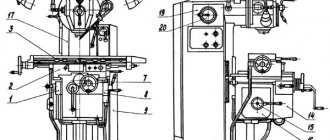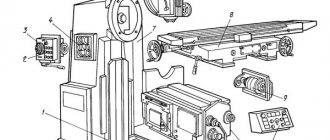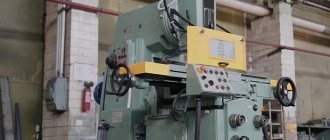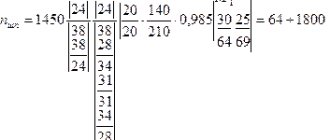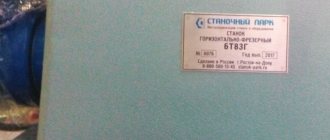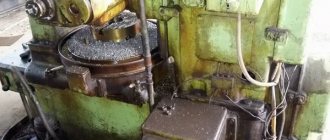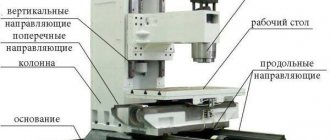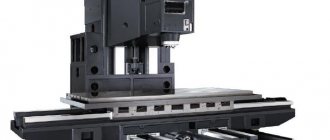For general purpose milling and carpentry work, an excellent 6P10 machine is suitable. It is a multifunctional unit that processes wood and metal in large volumes.
Therefore, the machine has become popular among large and small entrepreneurs. Such equipment allows you to perform a wide range of tasks. The multitasking of milling cutters also depends on the design features and specific purpose of the cutter.
Information about the manufacturer of the 6P10 milling machine
The 6P10 milling machine was produced by the Vilnius Machine Tool Plant .
In 1947, the machine tool manufacturing plant produced its first products - 13 tabletop drilling machines.
In 1949, the development of more complex products began - cross-planing machines, followed by the production of horizontal, vertical and universal cantilever milling machines.
Machine tools produced by Vilnius Machine Tool Plant
- 6E80sh
- universal cantilever milling machine 200 x 800 - 6M80
- horizontal cantilever milling machine with rotary table (universal) 200 x 800 - 6N10
- vertical cantilever milling machine 200 x 800 - 6N80
- horizontal cantilever milling machine with rotary table (universal) 200 x 800 - 6N80G
- horizontal cantilever milling machine 200 x 800 - 6N80SH
- universal universal cantilever milling machine 200 x 800 - 6P80G
- horizontal cantilever milling machine 200 x 800 - 6Р10
- vertical cantilever milling machine 200 x 800 - 6Р80
- horizontal cantilever milling machine with rotary table (universal) 200 x 800 - 6R80G
- horizontal cantilever milling machine 200 x 800 - 6Р80Ш
- universal universal cantilever milling machine 200 x 800 - 6T10
- vertical cantilever milling machine 200 x 800 - 6T80
- horizontal cantilever milling machine with rotary table (universal) 200 x 800 - 6T80SH
- universal cantilever milling machine 200 x 800 - NS-12A
- tabletop drilling machine Ø 12 - SUS-1
desktop drilling machine Ø 12
Production history
The 6P10 version of the cantilever milling machine came off the assembly lines of the Vilnius plant - the Zalgiris machine tool manufacturing plant - for the first time. The first machines at the plant began to be designed and produced in 1947.
At first, all units were designed for drilling and cross-planing work, then engineers produced horizontal and vertical models, and they also began producing universal milling machines, which were increasingly similar to modern models, including 6P10.
Latvian new products from Zalgiris, semi-automatic milling machines, universal mechanisms, and specialized precision ones, became recognizable throughout the country, as well as in the USSR. Since the late 70s, the production of cantilever-milling units of various models has been launched:
- 6R80G - horizontal, base model for other modifications;
- 6P80 - universal version;
- 6P10 - vertical milling modification.
REFERENCE. Today, the 6P10 machine is the most popular not only among entrepreneurs, but also among professional amateur turners.
6P10 vertical cantilever milling machine for general purpose. Purpose, scope
The vertical cantilever milling machine 6P10 is designed for milling all kinds of parts from various materials.
The horizontal milling machine model 6Р80Г is the basic model, and the universal milling machine model 6Р80 and vertical milling machine model 6Р10 are its modifications.
Design features and operating principle of the machine
On a universal milling machine model 6P80, using a universal dividing head, you can mill spiral grooves on cylindrical parts, as well as perform various milling operations associated with rotating the part by a given amount.
The rotating milling head with a retractable sleeve of the vertical milling machine model 6P10 allows milling work on inclined surfaces of the part.
The overhead rotary milling head N80G.28 with a vertical spindle, available on special order for an additional fee, expands the technological capabilities of the 6R80G and 6R80 machines.
The machine is designed to perform various milling operations in single and batch production.
Roughness of the machined surface at finishing cutting conditions V 6.
Unlike previously produced machines of this type, the new machine is characterized by reduced noise, increased durability of the main components and preservation of accuracy standards for a longer period. The electrical equipment is mounted in a spacious niche and meets all modern requirements. Table feed control is separate. There are protective devices that protect the worker from chips and splashes of coolant. The cooling system is equipped with quick-release settling tanks. The appearance of the machine meets modern requirements of industrial aesthetics.
It is not possible to integrate the machine into an automatic line.
Machine accuracy class N.
Rules and operating instructions, passport
The operator who maintains the machine must remember that he is responsible for the performance and technical condition of the equipment, so the following rules must be adhered to:
- Before starting up the equipment, inspect the power cable to make sure there are no defects.
- Inspect the cooling system and its connections to the device, check for the presence of cooling fluid.
- Start the aspiration system before operating the machine.
- Check the cutting tools (do not touch the cutter with bare hands).
- Remove foreign objects from the work area or keep people incompetent in milling away.
- Securely secure the workpiece or sheet material on the workbench.
Operation begins with compliance with the workflow requirements:
- Load electronic material into the machine’s memory or run it on an adjacent computer.
- Set parameters for milling, for example, spindle path, speed modes, power, types of processing, entry and end points.
- Check the correct operation of the limit sensors.
- Check the spindle head, it should be in zero coordinates.
- Before starting work, put on special protective clothing and glasses.
- The router is controlled electronically, but you should not leave it unattended during operation.
Completion of work must also be carried out in accordance with the following rules:
- Completion of the machine’s working process ends with the removal of materials from the table and the return of the spindle to zero coordinates (if this was not indicated in the program on the computer).
- Before starting the next production cycle or finishing the production process on the equipment, the table is cleaned of debris, dust, and waste.
- Disconnect the equipment from the power supply.
The milling machine passport can be downloaded for free from the link – Passport for the 6P10 cantilever vertical milling machine.
A cantilever milling machine requires compliance with basic safety rules and care of the milling machine:
| Safety rules | Care instructions |
| It is prohibited to touch all moving elements with your hands while the machine is operating; | Regularly clean racks, guides, gears from dust, shavings and other waste; after cleaning, lubricate all elements; |
| the operator’s clothing must be appropriate for the work process; | control the temperature and increase it to more than 60 degrees; if the machine is located in an unheated room, then do not allow the coolant to freeze; |
| carry out timely replacement of the cutting tool after turning off the machine from the power supply; | check the condition of the electrical panel; |
| stop using the “STOP” button, and use the same button to prevent spontaneous start-up of the equipment. | carry out comprehensive diagnostics; |
| When making repairs, use the tools from the main kit (provided after purchasing the machine as a set). |
Location of components of the 6P10 cantilever milling machine
Location of components of the 6P10 milling machine
List of components of the 6P10 cantilever milling machine
- Console movement switching mechanism - 6Р80Г.42
- Slides of machines 6Р80Г and 6Р10 - 6Р80Г.50
- Table - 6Р80Г.51
- Bed of machines 6Р80Г and 6Р80 - 6Р80Г.10
- Trunk of machines 6Р80Г and 6Р80 - 6Р80Г.11
- Cooling of machines 6Р80Г and 6Р80 - 6Р80Г.60
- Cross feed nut - 6Р80Г.43
- Switching mechanism for moving the slide - 6Р80Г.42
- Electrical cabinet - 6Р80Г.70
- Main drive of machines 6Р80Г and 6Р80 - 6Р80Г.20
- Speed switching mechanism of machines 61Р80Г and 6Р80 - 6Р80Г.22
- Suspension of machines 6Р80Г and 6Р80 - 6Р80Г.16
- Suspension of machines 6Р80Г and 6Р80 - 6Р80Г.13
- Console - 6Р80Г.40
- Feed switching mechanism - 6Р80Г.32
- Feed box - 6Р80Г.30
- Machine bed - 6Р10 - 6Р10.10
- Cooling of the machine 6Р10 - 6Р10.60
- Main drive of the machine 6Р10 - 6Р10.20
- Machine speed switching mechanism 6Р10 - 6Р10.22
- Milling machine head 6Р10 - 6Р10.21
Location of controls for the 6P10 cantilever milling machine
Location of controls for the 6P10 milling machine
List of controls for the 6P10 cantilever milling machine
- Handle for manual console movement
- Handle for manual movement of the slide
- Vertical feed switch handle
- Button for enabling rapid movement of the table, slide and console
- Flywheel for manual table movement
- Backlash sampling worm in a table screw-nut pair
- Cooling tap
- Load indicator
- Power switch handle
- Light switch
- Signal lamp
- Stop button
- Slide Clamp Handle
- Cross feed switch handle
- Start button
- Console Clamp Handle
- Feed motor activation handle
- Electric cooling pump activation handle
- Spindle rotation direction switch
- Spindle Jog button
- Spindle override handle
- Spindle speed setting handle
- Trunk Clamp Screws
- Trunk movement shaft
- Longitudinal feed switch handle
- Table Clamp Screws
- Screws for clamping the rotary slide of the machine 6Р80
- Feed rate setting handle
- Machine spindle sleeve clamping handle 6P10
- Handle for moving the spindle sleeve of the machine 6P10
Kinematic diagram of the 6P10 cantilever milling machine
Kinematic diagram of the 6P10 milling machine
Limits of use of 6P10 machines
Limits of use of machines The full value of the strokes indicated in the passport can be used only if there are no parts or devices on the machine table that limit the movement of the table. For example, when using a round rotary table and installing a mandrel with a cutter in the spindle, the vertical stroke of the table is reduced; when installing a dividing head with a guitar, the longitudinal travel of the table is reduced; When installing workpieces between the table and the frame mirror, the transverse movement of the table is reduced.
To use full mechanical movements of the table, it is necessary to set the switch stops to their extreme positions. In this case, it is necessary to monitor the operation of the moving parts of the machine to eliminate the possibility of their breakdown.
When working with a mechanical drive, the dividing head is installed at the right end of the table. The dividing head spindle receives rotation from the table lead screw through the guitar's replaceable gears, for installation of which it is necessary to remove the protective bracket at the right end of the table.
Operating mode of the machine 6Р10
At high and medium spindle speeds, the limits of machine use are limited mainly by the permissible cutting speeds for cutters and the power of the main motion electric motor.
If vibrations occur in some modes, it is recommended to change the feed rate per tooth or use cutters with an uneven pitch and a large angle of inclination of the chip flutes.
Working with end mills on steel
- Cutter diameter - 80 mm
- Number of cutter teeth - 16
- Milling width - 40 mm
- Milling depth - 3 mm
- Spindle speed per minute - 140 rpm
- Cutting speed - 35 m/min
- Feed – 280 mm/min
- Feed per tooth - 0.12 mm
To achieve high surface cleanliness and high dimensional accuracy when working with high-speed steel cutters, it is recommended to work at a feed per tooth S = 0.02..0.03 mm, with a milling depth t = 0.3..0.5 mm and cutting speed V = 17..25 m/min.
Limits of use of 6P10 machines
Limits of use of machines The full value of the strokes indicated in the passport can be used only if there are no parts or devices on the machine table that limit the movement of the table. For example, when using a round rotary table and installing a mandrel with a cutter in the spindle, the vertical stroke of the table is reduced; when installing a dividing head with a guitar, the longitudinal travel of the table is reduced; When installing workpieces between the table and the frame mirror, the transverse movement of the table is reduced.
To use full mechanical movements of the table, it is necessary to set the switch stops to their extreme positions. In this case, it is necessary to monitor the operation of the moving parts of the machine to eliminate the possibility of their breakdown.
When working with a mechanical drive, the dividing head is installed at the right end of the table. The dividing head spindle receives rotation from the table lead screw through the guitar's replaceable gears, for installation of which it is necessary to remove the protective bracket at the right end of the table.
Design and operation of the 6P10 machine
Main drive of the 6P10 machine
The kinematic diagrams of the main drive of the 6R80G and 6R80 machines are the same. The spindle rotates from an electric motor through a V-belt transmission and a gearbox. When moving gear blocks on shaft II-II and switching gears on the spindle, 12 speeds are obtained.
The kinematic diagram of the main drive of the 6P10 machine is similar to that of the 6P80G and 6P80 machines, only the drive is located on a separate shaft and, together with the spindle, is built into the milling head.
Feed drive of the machine 6Р10
The kinematic diagram of the feed drive is the same for all machines. The rotation of the feed drive shafts VIII, IX, X, XI, XII, XIII is carried out by an electric motor.
Working feed is carried out with the electromagnetic clutch turned off. The rotation from the feed box is transmitted through the overrunning clutch to the XIV console shaft.
The kinematic chain of accelerated movements of the table comes from the electric motor through shafts VIII, IX, X, XIII, electromagnetic clutch, overrunning clutch and console shaft XIV.
The inclusion and reversal of longitudinal, transverse and vertical feeds is carried out by double-sided cam clutches 25, 32, 39.
Machine bed 6Р10
The machine bed consists of a base, a stand, an electrical cabinet, a casing and a trunk with hangers (on the 6P10 machine there is no trunk and hangers).
The following are installed on the base: a stand, a bracket with a nut for the console lifting screw and a cooling pump.
The internal cavity of the base is a reservoir for coolant.
An electrical cabinet is attached to the right side of the rack, and a gearbox and gear shift mechanism are located in the upper part.
Suspensions are attached to the trunk of the 6R80G and 6R80 machines, which serve as supports for the milling mandrels. One of the suspensions has a rolling support, the other has a sliding support.
A special feature of the 6P10 machine bed is the presence of a flange in its upper part for attaching the milling head.
Gearbox and spindle of the 6P10 machine
Gearbox for console milling machine 6р10
The spindle drive of the 6R80G and 6R80 machines consists of an electric motor, a V-belt drive, a six-speed gearbox, a spindle and a gearbox, built into the machine assembly.
Double-row roller bearings with the inner ring seated on a cone are used as the front support of the spindle. To absorb axial forces, angular contact ball bearings are installed in the rear support.
The spindle drive of the 6P10 machine is distinguished by the presence of a bust shaft and a retractable sleeve located in the milling head housing.
Console and feed box of the 6P10 machine
Feed box for console milling machine 6р10
The feed drive is located in the console. A flange electric motor is built into the front, in the lower part of the console; a feed box with a feed switching mechanism and a mechanism for enabling vertical movement of the console is mounted on the left side of the console, and a mechanism for moving the slide is mounted on the right side.
In addition to the working feed chain, the 12-speed gearbox has a rapid feed chain. The feed box contains safety clutch 1 (Fig. 15), which eliminates the possibility of gear breakage due to overload.
An electromagnetic clutch 2 and an overrunning clutch 3 are mounted on the same shaft with the safety clutch. The fast movements of the table, slide and console are activated by a button located on the front wall of the slide.
The handle and flywheel for manual movement of the table in the transverse and vertical directions are located on the front console.
The feed switching mechanism consists of a handle, a disk with profile grooves and levers. When the handle is moved up or down, the disc rotates and the levers move the forks and gears.
The mechanical movement of the console and slide is activated using handles located on the left and right sides of the console. The direction of movement of the handle is mnemonically linked to the direction of movement of the console and slide.
The rear wall of the console is made in the form of dovetail profile guides.
On the right side behind the console there is a handle for securing the console to the stand.
The upper part of the console has rectangular guides along which the slide moves.
Table and slide of machine 6Р10
The slide moves laterally on the console and has table guides.
Screw 1 (Fig. 18) for longitudinal feed is connected to the table. The slide contains bevel gears 2 that rotate the screw, handle and mechanism for turning on the longitudinal feed of the table.
To work with the down milling method, a mechanism is provided for sampling the gaps between the threads of the lead screw 1 and nuts 3 and 4.
When working with the up-milling method, the lead screw wears out a lot. Therefore, when one job is being performed on the machine for a long time, the area of operation of the screw should be changed.
The rotary slide on the 6P80 machine makes it possible to rotate the table within ±45° in the horizontal plane.
Electrical equipment of milling machine 6Р10
The electrical equipment installed on the machine is designed for a power circuit voltage of 380 V, 50 Hz three-phase alternating current. The following voltages are used in the control circuit:
- magnetic starter circuit ~ 110 V
- electrodynamic braking circuit ~ 55 V
- electromagnetic clutch circuit - 24 V
- local lighting circuit ~ 36 V
- signal lamp circuit ~22 V
The machine is equipped with three three-phase squirrel-cage asynchronous electric motors. Technical data of electric motors are given in the list of electrical devices attached to the circuit diagram.
Description of the operation of the electrical circuit of the 6P10 milling machine
By turning on the input circuit breaker A1, mains voltage is supplied to terminals A10, B10, C10, i.e., to the primary windings of control transformers TU1, TU2, TUZ and to the input contacts of the magnetic starter CL.
The machine is put into operation by pressing the KU2 button (symbol !). In this case, the CL magnetic starter is triggered, which, having closed its closing contacts in the power circuit, turns on the electric motors of the spindle drive DS, feed drive DS and electric pump BS.
For separate operation of electric motors ДШ, ДП, ДО there are, respectively, switches ПШ, ВП, ВН. In addition, the PSh switch is designed to change the direction of rotation of the DSh electric motor.
The machine is stopped by pressing the KU1 button (symbol O). By pressing the latter, the CL magnetic starter is turned off, which, in turn, turns off all electric motors.
When the KU1 button is pressed, the magnetic starter CT is turned on by the closing contact, which, together with the intermediate relay RP, by closing its closing contacts in the braking circuit, supplies direct current to the electric motor stator circuit. Electrodynamic braking of electric motors occurs. The duration of braking is determined by the pressed state of the KU1 button.
To turn on the accelerated movement of the table, there is a button KU4 (symbol), by pressing which, when the magnetic starter CL is turned on, the electromagnetic clutch MBH is turned on.
For short-term activation of electric motors there is a KUZ button (symbol T).
To turn on local lighting, switches B01, B02 are installed on the lamps.
Protection, blocking and signaling of the 6P10 milling machine
Protection of the electrical equipment of the machine from short circuits in the power circuit is carried out by automatic switches A1, A2 and in control circuits - by automatic switch A3 and fuses Pr1 - PrZ.
Overload protection of the spindle drive electric motors and the electric pump is carried out, respectively, by thermal relays RT1 and RT2. Overload protection of the DP feed drive electric motor is carried out by automatic switch A2.
Minimum protection of electric motors is provided by a CL magnetic starter.
The inability to turn on the electric motors when the rear door of the machine is open is ensured by the VK limit switch.
When the handle of the input switch is in the on position, it is impossible to open the door of the electrical cabinet, and when the door is open, the handle of the input switch cannot be turned on. This blocking is ensured by the design of the input switch handle. If it is necessary to turn on the input switch with the electrical cabinet door open for repair purposes, you must press rod E (Fig. 5 and 6), which extends when the door is opened.
The presence of mains voltage in the electrical circuits of the machine when the input circuit breaker A1 is turned on is indicated by the LS signal lamp.
After the input switch automatically turns off, its handle remains in the “on” position. The signal lamp then goes out. To turn it on again, you need to move the handle to the “Off” position and then switch it to the “on” position.
Technical characteristics of the cantilever milling machine 6P10
| Parameter name | 6Р80г | 6Р80 | 6Р10 | 6Р80Ш |
| Basic machine parameters | ||||
| Accuracy class | N | N | N | P |
| Dimensions of the working surface of the table, mm | 800 x 200 | 800 x 200 | 800 x 200 | 800 x 200 |
| Distance from the spindle axis to the table surface, mm | 50..350 | 50..350 | — | 50..350 |
| Distance from the end of the spindle to the table surface, mm | — | — | 50..350 | 50..350 |
| Maximum distance from the end of the spindle to the shackle bearing, mm | 450 | 450 | — | 350 |
| Distance from the spindle axis to the trunk, mm | 123 | 123 | — | 123 |
| Distance from the rear edge of the table to the vertical guides of the frame, mm | 80..240 | 80..240 | 80..240 | 80..240 |
| Distance from the spindle axis to the vertical guides of the bed (overhang), mm | — | — | 265 | — |
| Spindle | ||||
| Horizontal spindle rotation speed, rpm | 50..2240 | 50..2240 | — | 50..2240 |
| Vertical spindle rotation speed, rpm | — | — | 50..2240 | — |
| Number of horizontal and vertical spindle speeds | 12 | 12 | 12 | 12 |
| Movement of the spindle quill (sleeve), mm | — | — | 60 | 60 |
| Movement of the spindle quill by one dial division, mm | — | — | 0,05 | 0,05 |
| Angle of rotation of the milling head in the longitudinal plane, degrees | — | — | ±45° | ±90° |
| End of horizontal spindle according to GOST 836-72 | 40 | 40 | — | 40 |
| End of vertical spindle according to GOST 836-72 | 40 | 40 | — | 40 |
| Milling head spindle | ||||
| Angle of rotation of the milling head in the transverse plane, degrees | — | — | — | +30°-45 |
| Inner taper of milling head spindle | — | — | — | Morse 4 |
| Milling head spindle rotation speed, rpm | — | — | — | 56..2500 |
| Number of spindle speeds of the milling head | — | — | — | 12 |
| Table. Table feed | ||||
| Maximum longitudinal stroke of the table (X), mm | 500 | 500 | 500 | 500 |
| Maximum transverse travel of the table (Y), mm | 160 | 160 | 160 | 160 |
| Maximum vertical travel of the table (Z), mm | 300 | 300 | 300 | 300 |
| Limits of table rotation, degrees | — | — | ±45° | — |
| Limits of longitudinal table feeds (X), mm/min | 25..1120 | 25..1120 | 25..1120 | 25..1120 |
| Limits of table cross feeds (Y), mm/min | 25..1120 | 25..1120 | 25..1120 | 25..1120 |
| Limits of vertical table feeds (Z), mm/min | 12,5..560 | 12,5..560 | 12,5..560 | 12,5..560 |
| Number of table feed stages (longitudinal, transverse, vertical) | 12 | 12 | 12 | 12 |
| Speed of fast movements (longitudinal, transverse/vertical) X, Y/ Z, m/min | 2,3/ 2,3/ 1,12 | 2,3/ 2,3/ 1,12 | 2,3/ 2,3/ 1,12 | 2,3/ 2,3/ 1,12 |
| Movement of the table by one dial division (longitudinal, transverse/vertical), mm | 0,05/ 0,02 | 0,05/ 0,02 | 0,05/ 0,02 | 0,05/ 0,02 |
| Table movement per one revolution of the dial (longitudinal, transverse/vertical), mm | 6/ 2 | 6/ 2 | 6/ 2 | 6/ 2 |
| Maximum permissible cutting force (longitudinal/transverse/vertical), kg | ||||
| Machine mechanics | ||||
| Feed stops (longitudinal, transverse, vertical) | Eat | Eat | Eat | Eat |
| Blocking manual and mechanical feeds (longitudinal, transverse, vertical) | Eat | Eat | Eat | Eat |
| Blocking separate feed switching | Eat | Eat | Eat | Eat |
| Spindle braking | Eat | Eat | Eat | Eat |
| Overload safety clutch | Eat | Eat | Eat | Eat |
| Electrical equipment and machine drives | ||||
| Number of electric motors on the machine | 3 | 3 | 3 | 4 |
| Electric motor of main movement ДШ, kW (rpm) | 3,0 (1430) | 3,0 (1430) | 3,0 (1430) | 3,0 (1430) |
| Electric feed drive motor DP, kW (rpm) | 0,8 (1360) | 0,8 (1360) | 0,8 (1360) | 0,8 (1360) |
| Coolant pump electric motor, kW (rpm) | 0,12 (2800) | 0,12 (2800) | 0,12 (2800) | 0,12 (2800) |
| Electric motor of the milling head DG, kW (rpm) | — | — | — | 1,1 (1400) |
| Total power of all electric motors, kW | ||||
| Dimensions and weight of the machine | ||||
| Machine dimensions (length width height), mm | 1525 x 1875 x 1515 | 1525 x 1875 x 1515 | 1435 x 1875 x 1750 | 1820 x 1875 x 1765 |
| Machine weight, kg | 1240 | 1260 | 1270 | 1340 |
- Cantilever milling machines 6Р80Г, 6Р80, 6Р10, 6Р80Ш. Operating manual 6Р80Г.00.000 РЭ, 1978
- Console milling machines 6Р80Г, 6Р80, 6Р10. Operating manual 6Р80Г.00.000 РЭ, 1974
- Console milling machines 6Р80Г, 6Р80, 6Р10. Operating manual for electrical equipment 6Р80Г.00.000 РЭ1, 1974
- Avrutin S.V. Fundamentals of Milling, 1962
- Avrutin S.V. Milling, 1963
- Acherkan N.S. Metal-cutting machines, Volume 1, 1965
- Barbashov F.A. Milling business 1973, p.141
- Barbashov F.A. Milling work (Vocational education), 1986
- Blumberg V.A. Milling machine handbook, 1984
- Grigoriev S.P. Practice of coordinate boring and milling work, 1980
- Kopylov R.B. Working on milling machines, 1971
- Kosovsky V.L. Handbook of a young milling operator, 1992, p. 180
- Kuvshinsky V.V. Milling, 1977
- Nichkov A.G. Milling machines (Machinist's Library), 1977
- Pikus M.Yu. A mechanic's guide to repairing metal-cutting machines, 1987
- Plotitsyn V.G. Calculations of settings and adjustments of milling machines, 1969
- Plotitsyn V.G. Setting up milling machines, 1975
- Ryabov S.A. Modern milling machines and their equipment, 2006
- Skhirtladze A.G., Novikov V.Yu. Technological equipment for machine-building industries, 1980
- Tepinkichiev V.K. Metal cutting machines, 1973
- Chernov N.N. Metal cutting machines, 1988
- Frenkel S.Sh. Handbook of a young milling operator (3rd ed.) (Vocational education), 1978
Bibliography:
Related Links. Additional Information
- Milling machines: general information, classification, designation
- Comparative characteristics of cantilever milling machines of the 6N, 6M, 6R, 6T
- Feed box for console milling machines of the 6M : 6M12P, 6M13P, 6M82, 6M83, 6M82Sh, 6M83Sh
- Feed box for console-milling machines of the 6P : 6Р12, 6Р13, 6Р82, 6Р83, 6Р82Ш, 6Р83Ш Feed box for console-milling machines of the 6Т : 6T12, 6T13, 6T82, 6T83, 6Т82Ш, 6Т83Ш
Electrical equipment of milling machines of the Gorky Machine Tool Plant, GZFS
Electrical equipment of milling machines of the Vilnius Zalgiris Machine Tool Plant
Specifications
The cantilever milling machine version 6P10 has the following technical indicators:
| Characteristic | Measurement |
| Accuracy class | N |
| Working surface dimensions | 800 x 200 mm |
| Machine weight | 1270 kg |
| Dimensions of the device | length - 1435 mm; |
| width - 1875 mm; | |
| height - 1750 mm. | |
| Groove parameters | number of grooves - 3; |
| width - 14 mm; | |
| the distance between them is 50 mm. | |
| Working surface movement speed | transverse movement, longitudinal - 2300 mm/min; |
| vertical -1120 mm/min. | |
| Spindle parameters | 12 steps; |
| vertical spindle is Morse 4; | |
| rotation with a frequency of 56…2500 rpm; | |
| dial division price 0.05 mm; | |
| quill parameter along the axis is 60 mm; | |
| the largest rotation angle in the longitudinal plane is from -45 to +45 degrees. |
